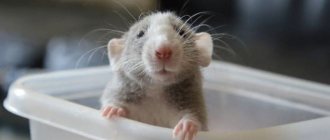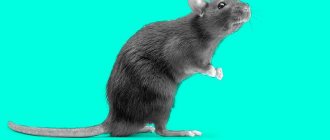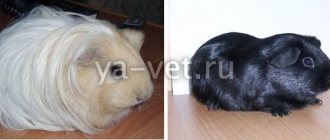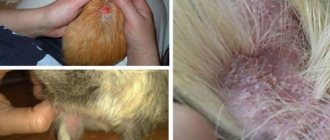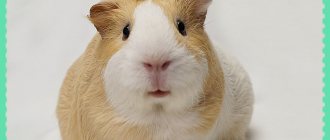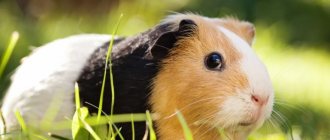Structure of teeth
Pigs only have 20 teeth. Those that are visible from the outside are 2 pairs of incisors. Inside there are so-called “cheek” or chewing teeth (in veterinary terminology – premolars and molars). Guinea pigs have no fangs.
The chewing teeth are not visible from the outside, so if problems arise with them, it cannot be determined visually. You need to carefully monitor the general condition of the pet, its behavior, and also regularly weigh the animal in order to track the problem in time and come to its aid.
The hamster is sick - the hamster has eyes
From: Julia Tel.: 892520
Message: Good afternoon, my hamster is sick, half my wife; age - 1.10. A week ago she became inactive, about three days ago she walked with her eyes closed and pressed herself to the bottom of the dune, while raking the litter beneath her, I thought maybe she was hot... she walked staggering, the next day her muzzle looked strange, as if it was swollen in the forehead area, and yesterday the right the eye has become enlarged and does not close at all, today it is open and as if withered, and the second eye is closed, and the muzzle is somehow deformed. The napkins in the house are a little bloody. He eats little, only sleeps, and doesn’t seem to wash himself under his tail. How to help, what to do, I understand, maybe age, but she looks very sad...
Good afternoon There is an inflammatory reaction associated with sinusitis and inflammation of the eye - uveitis. I also do not rule out ulcerative keratitis. But here it is necessary to conduct an ophthalmological examination. Here you should drop Tobrex into the eye 3-5 times a day, and give the drug Immunim in the mouth (let him chew) or through a drinking bowl, but then you cannot give vegetables and fruits, but only grains and water. Vitamins C and B1 are also shown. You can, in principle, inject them - even subcutaneously! However, despite the prescribed treatment, so to speak, virtually, I would recommend contacting our veterinarian, especially since two of our veterinarians, namely M.N. Kocherga and I, have a specialization in rodent ophthalmology. So you can make an appointment with any of our specialists. Sincerely, Vladimir Romanov
Causes
The reasons can be either genetically determined or acquired.
In the first case, this may be the consequences of violating the rules of crossing (closely related variant) due to the fault of the breeder.
In the second case, the wrong diet is to blame. If the owner gives his pet food that is tastier (in his opinion), and often pampers him with soft dry food and store-bought treats, then the balance between rough and soft food is upset, the teeth stop grinding down, but do not stop growing. And then the above-described dental problem arises.
Choose food for guinea pigs in the catalog.
Hums
Rumbling sounds can have a variety of meanings, depending on the position you are currently occupying. If the pig is currently feeling content and happy, then it will emit a guttural rumbling against the background of absolute relaxation and ease. However, if the rumbling sounds have a higher pitch, then the animal is most likely irritated by something. Tension in movements will also indicate this. If you take a closer look at the pet, you can see that it trembles while purring. But abrupt rumbling sounds clearly indicate that your pig is scared or feels uncomfortable.
Symptoms
Alarm signals indicating the presence of a problem are changes in the behavior of the guinea pig and the nature of physiological functions:
- weight loss
- refusal to eat
- increased salivation (the animal “chomps” while eating), drooling
- inability to chew food normally (the animal drops pieces from the mouth)
- diarrhea (due to inability to chew hay and choosing soft foods)
- tearing while eating (because it hurts to chew)
- Lack of bowel movements or irregular bowel movements due to malnutrition
- increasing the duration of food intake (chews slower than usual)
Usually, all this indicates that a malocclusion has formed and the mumps needs urgent medical attention. If emergency treatment is not possible and your pet is unable to eat and is losing weight, you can feed him liquid food. To do this, feed granules need to be soaked in water until they become a paste. You can use a syringe for feeding, from which the part near the “spout” is cut off so that only the tube and the piston remain. This way you will save him from starvation.
Please contact your operator for the cost of services not listed in the price list.
| Veterinary services | Cost, rub. |
| Vaccination of animals, vaccinations | |
| Routine cat vaccination | 550 |
| Routine dog vaccination | 650 |
| Vaccination of dogs at home | 900 |
| Vaccinations for puppies | 600-1000 |
| Vaccinations for kittens | 500-900 |
| Vaccination against rabies in dogs | 1250 |
| Veterinarian at home for vaccination | 400 |
| Animal surgery (surgery for dogs, surgery for cats) | |
| Removal of papillomas | 500 |
| Removal of subcutaneous tumor | 600-1500 |
| Cat sterilization | 1900 |
| Sterilizing a cat at home | 2250 |
| Castration of cats | 1450 |
| Castration of cats at home | 1700 |
| Dog sterilization | 2700 |
| Dog castration | 2200 |
| Sterilization of cats laparoscopy | 2900 |
| Castration of a male dog | 2700 |
| Sterilization of dogs laparoscopy | 3200 |
| Tail fracture in a dog, treatment | 900 |
| Fractures in dogs | 1100 |
| Fracture/dislocation in a dog | 900 |
| Fracture/dislocation in a cat | 900 |
| Pinched toes in dogs | 1300 |
| Amputation of vestigial digits in dogs | 1150 |
| Animal therapy | |
| Treatment of wounds and surgical sutures | 250-350 |
| Removing stitches for a dog or cat | 200-350 |
| Injections for a cat | 300-400 |
| Injections for a dog | 400-500 |
| Probing the dog's esophagus | 1380 |
| Gastric lavage in a dog | 1550 |
| Euthanasia of animals | |
| Put the dog to sleep | 2400 |
| Putting a dog to sleep at home | 2600 |
| Put the cat to sleep | 1600 |
| Euthanasia of cats | 1600 |
| Euthanasia of a cat at home | 1800 |
| Animal cremation | |
| General pet cremation | 1500-2500 |
| Individual animal cremation | 3500 |
| Cremation of dogs (up to 10 kg) | 3000 |
| Cremation of dogs (from 10 to 20 kg) | 5000 |
| Cremation of a dog over 20 kg | negotiable |
| Cremation of cats | 1550 |
| Animal diseases and their treatment | |
| Inflammation of the ear in a dog, otitis media | 1150 |
| Toxoplasmosis in a dog | 1450 |
| Piroplasmosis in dogs treatment | 1850 |
| Dermatitis in a dog | 950 |
| Rhinitis in dogs treatment | 970 |
| Stomatitis in a dog | 970 |
| Treatment for styes in dogs | 980 |
| Urolithiasis in cats | 1850 |
| Heart failure in a cat/dog | 1600-1900 |
| Feline panleukopenia | 2140 |
| Toxoplasmosis | 950 |
| Distemper in a dog | 950 |
| Staphylococcus in a dog | 850 |
| Piroplasmosis in a dog/cat | 1800 |
| Ringworm in cats and dogs | 100-800 |
| Worms in a cat | 700-1200 |
| Veterinarian services | |
| Calling a veterinarian to your home | 400 |
| Vet visit at night | 600 |
| Veterinarian ophthalmologist reception in veterinary clinic | 1200 |
| Doctor ratologist reception in veterinary clinic | 1250 |
| Turtle doctor (herpetologist) | 1250 |
| Treatment of ferrets | 1050 |
| Treatment of rats | 1050 |
| Treatment of rodents | 1100 |
| Treatment of hamsters | 1100 |
| Reptile doctor | 1600 |
| Treatment of mice | 1100 |
| Animal grooming. grooming salon | |
| Calling a veterinarian-groomer to your home | 1200 |
| Dog grooming | 1300 |
| Cat grooming | 980 |
| Washing and drying dogs | 630 |
| Model dog haircut | 1560 |
| Hygienic cat grooming | 1050 |
| Removing tangles | 690 |
| Trimming cat's claws | 590 |
| Trimming dog's nails | 790 |
| Zoohotel | |
| Dog foster care | 380 |
| Hotel for cats | 270 |
| Hotel for dogs (for stays longer than 7 days) | 350 |
| Dog foster care (vip conditions) | 800 |
| Overexposure of large breed dogs | from 800 |
| Tests for animals | |
| Adenovirus/canine hepatitis | 600 |
| Blood test for infections (PCR) | 750-1900 |
| Canine herpes virus | 630 |
| Borelliosis Lyme disease | 650 |
| Feline calicivirus | 630 |
| Brucellosis | 650 |
| Epstein-Barr virus | 650 |
| Leptospirosis | 650 |
| Mycoplasmosis | 650 |
| Canine piroplasmosis | 660 |
| Panleukopenia | 650 |
| Parvovirus enteritis | 650 |
| Carnivore plague | 550 |
| Diagnostics for animals | |
| Radiography 1 projection | 1000 |
| X-ray 2 projections | 1700 |
| Echokg for animals | 2400 |
| ECG (electrocardiography) | 3000 |
| Ultrasound examination of all organs | 2500 |
| Ultrasound for cats (one organ) | 1450 |
| Ultrasound for dogs (one organ) | 1600 |
| Dentistry for animals | |
| Removing tartar from a cat | 2160 |
| Removing tartar from a dog | 2380 |
| Cat teeth extraction | 480 |
| Dog tooth extraction | 690 |
| Assistance in childbirth for animals | |
| Conservative obstetrics | 1000 |
| Cat birth assistance in adoption | 1200 |
| Examination of a cat before birth | 900 |
| Childbirth in a cat, help with complications | 1500 |
| Childbirth in a dog, help from a veterinarian | 1920 |
| Caesarean section for a cat | 3000 |
| Caesarean section for a dog | 5000 |
Health care
It is important that your animal falls into the hands of a qualified specialist. The procedure for trimming a guinea pig's side teeth is painful and is done under anesthesia, but if the animal has lost a lot of weight during the illness, anesthesia can be fatal. An experienced doctor will be able to quickly carry out the procedure without anesthesia, using special instruments, and trim the teeth so as to obtain a physiologically correct bite.
The procedure for trimming or filing the front incisors is simpler and less painful.
Very important! Arbitrary (untimely, incorrect or too short) cutting of teeth can lead to the fact that the pig will not be able to eat on its own.
When to see a doctor
The most common reasons for visiting a doctor are:
- Uneven chipped tooth
- Very sharp edge of a broken tooth,
- Damage to the oral mucosa,
- The appearance of purulent wounds and ulcers on the gums,
- Increased salivation
- The appearance of an unpleasant odor from the animal’s mouth,
- The appearance of signs of the wrong sign,
- Lack of appetite,
- Simultaneous loss of more than three teeth.
All these reasons are easy to identify when examining the oral cavity. Only a veterinarian can correct the situation and prescribe, if necessary, proper treatment and nutrition. Self-medication can make the situation worse.
Other dental problems
A guinea pig's teeth can crumble and break due to a lack of vitamin C in the diet. This is why it is so important to ensure that your pet's diet is balanced. If necessary, you can give him vitamin C tablets (dose – 25 mg). But it is better not to self-medicate, but to show the mumps to a specialist.
Lost teeth in guinea pigs grow back, just like broken ones. If the hole of a fallen tooth bleeds, it should be washed with salt water at the rate of 1 tsp. per glass of boiled water.
If the animal breaks a tooth, you need to make sure that the broken edge does not injure its cheeks. Otherwise, contact a specialist for correction.
What to do to wean
Although chewing on bars quickly becomes a real bad habit for your pet, weaning it off through training or punishment will not work here. To force the pig to abandon this action, you will need to eliminate all possible causes of its occurrence and try to improve the conditions for keeping the animal as much as possible.
First of all, you should increase the space for keeping your pet if the area of its home is below normal. In addition to purchasing a larger cage, you can equip the animal with a place for daily walks in the apartment. Fence a place on the floor or on the sofa, put an unnecessary blanket, build a shelter - your pet will be curious to explore the new space and make up for the lack of movement.
It is also important to make the cage comfortable for the pig - equip a cozy house, hang a hammock, put toys.
Guinea pig toys
If your pet is kept alone because you don't want to breed, you might consider adding a same-sex neighbor. Try to pay more attention to the pig every day - play with it in the evenings, hold it in your arms, this will help make up for the lack of social contacts.
Check the correctness of your pet’s diet - whether he is getting enough grains and hay, add fresh vegetables and other succulent food if necessary. To avoid vitamin deficiency, you can buy vitamin complexes in granules or tablets at pet stores. They usually come in the form of treats, so pigs enjoy eating the pellets.
IMPORTANT: If all the conditions are met, and the pig is still chewing on the bars of the cage, the cause may be a real habit. In this case, it is recommended to lubricate the rods with menthol - the smell will repel the rodent for the first time. But this method will not work if there have been no qualitative changes in the conditions of detention - then the pungent smell will only increase the level of stress.
